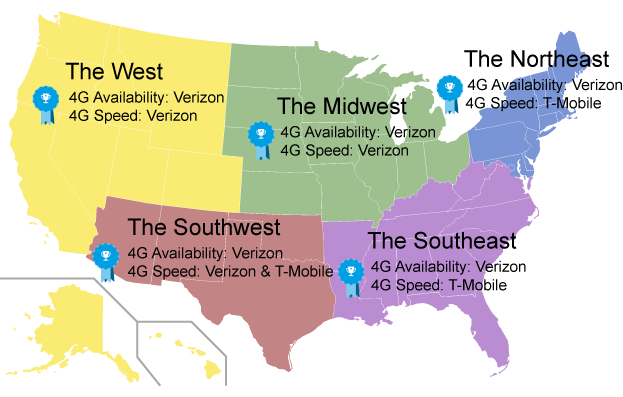
Last week OpenSignal released its semi-annual State of Mobile Networks report for the U.S., comparing the 3G and 4G performance of the big 4 nationwide. As we've done in previous reports, we also looked at LTE speeds and availability in the biggest metro markets, but we thought it would be interesting to make another pass at our geographic data, this time breaking down operator performance in the fourth quarter by broader region. We split the fifty states and the District of Columbia into five zones: The Midwest, Northeast, Southeast, Southwest and West. Then we let the data fall into place. Here's what we found.

It's plain to see Verizon's lead in 4G availability isn't just an overall national trend or big city phenomenon. It handily won first prize in all five of our regions, providing an LTE signal to our testers more often than any other operator. T-Mobile came in second in our 4G availability rankings in four regions, while in Southwest AT&T and T-Mobile ran neck and neck for second place. Sprint ranked the lowest in our LTE availability tests in every region.
While our regional availability rankings didn't reveal any big surprises, the data definitely got interesting when we started comparing regions to one another. First off, there appears to be a weak spot in 4G availability in the Southeast region. For every operator except AT&T, it was the lowest performing region in our tests. As for the best performing region for each operator, the results were more diverse. We measured the highest 4G availability for Verizon in the Midwest, where our users were able to latch onto a Verizon LTE signal 89.2% of the time. T-Mobile's forte was the densely packed Northeast corridor, where it scored 87.1% in LTE availability. AT&T shone brightest in the Southwest region, home to its corporate HQ, with a score of 84.8%. Sprint's best 4G availability in our tests was also in the Southwest. Our testers on Sprint were able to find an LTE connection 78.8% of the time within Texas, New Mexico, Oklahoma and Arizona.

Just as we saw in our national rankings, we had a real contest in 4G speed across the five regions. T-Mobile and Verizon split the awards down the middle. T-Mobile topped our LTE speed meter in the Northeast and Southeast, while Verizon won the Midwest and West. The final region, the Southwest, was an extremely close race, resulting in a statistical tie between the two operators.
In Speed, the regional differences in operator performance were starkly apparent. Verizon, for instance, was able to maintain an impressive 20 Mbps LTE download average across the Midwest in our tests -- that's a full 3 Mbps higher than its national average. Meanwhile T-Mobile performed the equally impressive feat of averaging more than 18 Mbps in our measurements across three of the five U.S. regions. AT&T's best test speeds were in the Northeast at 15.2 Mbps, while Sprint's best measured performance was in the Midwest, where it averaged 10.7 Mbps. The worst performing region was the Southwest, where we measured average speeds no greater than 14.4 Mbps on any of the four operators' networks.
Opensignal Limited retains ownership of this insight including all intellectual property rights, data, content, graphs & analysis. Reports and insights produced by Opensignal Limited may not be quoted, reproduced, distributed, published for any commercial purpose (including use in advertisements or other promotional content) without prior written consent. Journalists are encouraged to quote information included in Opensignal reports and insights provided they include clear source attribution. For more information, contact [email protected].
